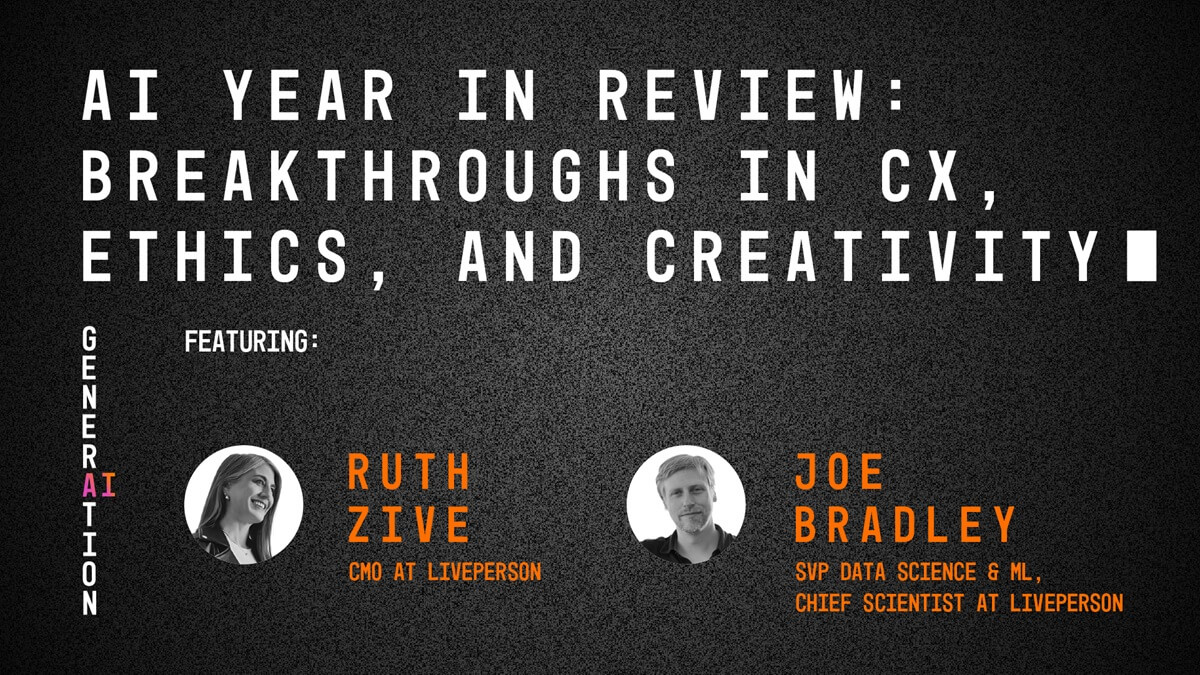PODCAST OVERVIEW
Year in review: Breakthroughs for AI in customer service, ethics, and creativity
From the unanswered questions to where we go from here to deliver more efficiency and better customer satisfaction
January 02, 2024 • 5 minutes

Looking back at 2023, Ruth Zive and Joe Bradley reflect on what a truly remarkable year it was in artificial intelligence. In their last podcast of that year, they dig into some of the year’s most pressing questions and exciting breakthroughs in what is still a largely undefined space. Highlighting how customers, employees, and brands across all industries have benefited from AI in the last year, Ruth and Joe share their predictions for the impact AI will have on businesses and their customer interactions throughout 2024 and beyond.
AI leaves questions unanswered in 2023
There seems to be somewhat of a misconception going into 2024 that things are settling down in the artificial intelligence space after a year of rapid growth and development. This is simply not true.
“Just when you think things have come back down to Earth, there’s some new development that sends us spinning again,” says Ruth.
The rapidly changing nature of the AI landscape is quickly hurdling AI into its big money era, which leaves many unanswered questions as we shift into the new year.
At the top of that list of questions: What’s going to happen to open source?
“We can see how the Windows and Mac operating systems are starting to come to life. But then we have the Linux side in the work done by many companies — though maybe led by Meta — toward open source and in-house model building for smaller operations. It’s a fascinating landscape. And the way that plays out in computing infrastructure and operating systems is you end up with different systems for different places,” Joe says.
While we may not know for sure what will happen to open source, natural language processing, or how those different systems might grow in 2024, imagining it along the way brings a lot of excitement and helps drive innovation.
Other queries floating around the AI chatbot space include:
- Are we going to have different AIs for different applications?
- Are we on the way to developing better a multimodal AI tool that better interacts with the physical world?
- Who will emerge as a major player in AI that we haven’t heard of yet?
- How will the vertical space around AI play out?
We may have to wait and see what happens to get answers to the questions we’ve been left with this year, but it is clear to see 2024 is going to be the year where more applications and AI tools come to life and pioneer more utility out of what came in 2023.
The evolution of ethics in AI development
With developers, customers, and even the general public constantly asking questions and having discussions about the safety and ethics of AI, 2023 saw the world moving toward safety (regarding AI technology) faster than we would have guessed based on past experiences.
“Safety with AI technology is one of the few things that a lot of legislators agree we need to take seriously and understand,” Joe says. “The work done on the EU AI Act and the World Economic Forum has brought many acts here with a lot of fast-moving concerns around safety.”
Even industry leaders are advocating for a break to do a circuit with Congress and an International Circuit to testify. According to Joe, this signifies a world that is aware that these processes and safety concerns are a priority that has perhaps been grazed over in previous technological revolutions.
“It’s a really healthy intention. However, awareness doesn’t always translate to execution,” Joe says.
That being said, the work done in 2023 has laid a solid foundation for continuation in the new year. We can now aim for better standards of trustworthy AI, higher expectations, and even laws to keep users safer and inspire a stronger sense of responsibility.
“At a minimum, we’ve landed in a place where there’s a consensus and awareness of the fact that safety responsibility needs to be a top-of-mind consideration. We need to establish a sense of balance relative to innovation and exploration. For example, you can’t over-index one versus the other. They need to be considerate of one another,” Ruth says.
The impact of AI in customer service operations
One of the areas in which AI development has shown what a sense of balance between innovation and exploration can achieve is customer service interactions, despite the idea that AI might reduce job availability.
“There was so much frenzy and some panic at the beginning over the idea that jobs are going to go away quickly,” Ruth says. “While I wouldn’t say that’s not going to be the case, what we’ve found at LivePerson and what customers have really validated is that AI and generative AI in the near term is going to augment human activities.”
This means customer service agents are becoming more efficient, more productive, and providing more meaningful experiences for their customers while diminishing costs for the brand.
Think of a time when you might have had a bad customer service experience. It likely included a customer service professional who wasn’t very helpful — maybe there were issues like repeatedly putting you on hold to ask their supervisor for assistance. Perhaps you could tell they were frustrated with the customer support process as well, which only frustrated you more.
Now imagine if there was an AI customer service chatbot that could help that agent access more information with better customer data context and better recommendations so that they didn’t have to keep putting you on hold. They likely would have been happier they resolved the issue faster, and your customer experience was smoother.
AI that helps customer service teams do their jobs better is a win-win for everyone from the customer to the support agents to the brand. In the coming year, more practical customer service AI applications like this are going to become real for more brands.
We also hope and expect to see practical applications that show more consideration between big language models vs. smaller, data-trained models for decision-making.
“For the right product and for the right development process, there can be a beautiful marriage of off-the-shelf, third-party generative models that do best-in-class language generation and tighter models for decision making and problem-solving that are needed to orchestrate conversations between people and machines that feel better than they’ve ever felt before,” says Joe.
Again, developing models that interact in a more realistic and human-like way is a win-win. It’s a good way to deliver a great experience and do it without breaking the bank — a problem many businesses are looking to overcome in 2024.

